check oil BMW M3 CONVERTIBLE 2002 E46 Owner's Manual
[x] Cancel search | Manufacturer: BMW, Model Year: 2002, Model line: M3 CONVERTIBLE, Model: BMW M3 CONVERTIBLE 2002 E46Pages: 159, PDF Size: 2.19 MB
Page 4 of 159

Contents
© 2001 BMW M GmbH
Munich, Germany
Reprinting, including excerpts, only with the
written consent of BMW M GmbH, Munich.
Order No. 01 41 0 156 249
US English VIII/01
Printed in Germany
Printed on environmentally friendly paper
(bleached without chlorine, suitable for recycling).
Overview
Controls and features
Cockpit14
Instrument cluster15
Indicator and warning lamps17
Steering wheel with multifunction
buttons21
Warning triangle22
First-aid kit22
Refueling22
Fuel specifications24
Tire inflation pressure24
Opening and closing:
Keys28
Central locking system28
Opening and closing Ð via the
door lock29
lOpening and closing Ð via the
remote control30
Opening and closing Ð from the
inside33
Luggage compartment lid34
Luggage compartment36
Alarm system37
Electric power windows39
Convertible top40
Adjustments:
Correct sitting position44
Seats44
Head restraints46
Entering the rear47
Safety belts48
Seat and mirror memory48
Seat heating49
Steering wheel50
Mirrors50
Passenger safety systems:
Airbags52
Transporting children safely54
Rollover protection system58
Vehicle Memory, Key
Memory60
Driving:
Steering/Ignition lock61
Starting the engine61
Switching off the engine62
Parking brake63
Manual transmission63
Sequential M gearbox SMG II64
Indicator/Headlamp flasher70
Washer/Wiper system/Rain
sensor71
Cruise control73
Everything under control:
Odometer75
Tachometer75
Engine oil temperature gauge75
Fuel gauge76
Temperature gauge76
Service Interval Display76
Check Control77
Clock77
Computer78
Technology for driving comfort
and safety:
Park Distance Control (PDC)80
Dynamic Stability Control
(DSC)81
Flat Tire Monitor82
M Engine dynamics control84
Contents
Page 17 of 159
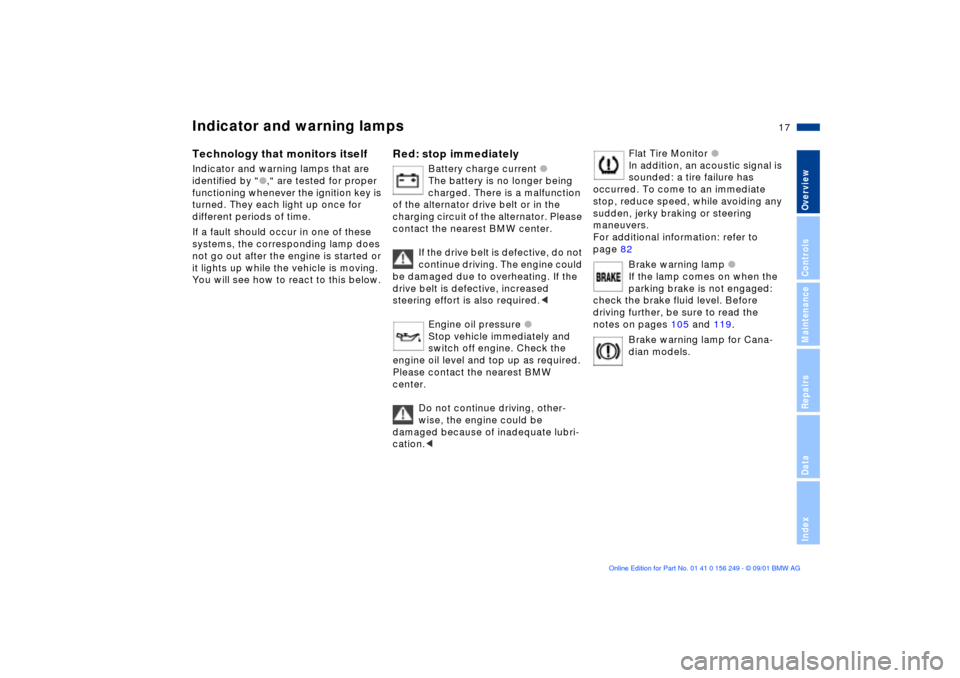
17n
OverviewControlsMaintenanceRepairsDataIndex
Indicator and warning lamps
Technology that monitors itself
Indicator and warning lamps that are
identified by "
l
," are tested for proper
functioning whenever the ignition key is
turned. They each light up once for
different periods of time.
If a fault should occur in one of these
systems, the corresponding lamp does
not go out after the engine is started or
it lights up while the vehicle is moving.
You will see how to react to this below.
Red: stop immediately
Battery charge current
l
The battery is no longer being
charged. There is a malfunction
of the alternator drive belt or in the
charging circuit of the alternator. Please
contact the nearest BMW center.
If the drive belt is defective, do not
continue driving. The engine could
be damaged due to overheating. If the
drive belt is defective, increased
steering effort is also required.
<
Engine oil pressure
l
Stop vehicle immediately and
switch off engine. Check the
engine oil level and top up as required.
Please contact the nearest BMW
center.
Do not continue driving, other-
wise, the engine could be
damaged because of inadequate lubri-
cation.
<
Flat Tire Monitor
l
In addition, an acoustic signal is
sounded: a tire failure has
occurred. To come to an immediate
stop, reduce speed, while avoiding any
sudden, jerky braking or steering
maneuvers.
For additional information: refer to
page 82
Brake warning lamp
l
If the lamp comes on when the
parking brake is not engaged:
check the brake fluid level. Before
driving further, be sure to read the
notes on pages 105 and 119.
Brake warning lamp for Cana-
dian models.
Page 19 of 159
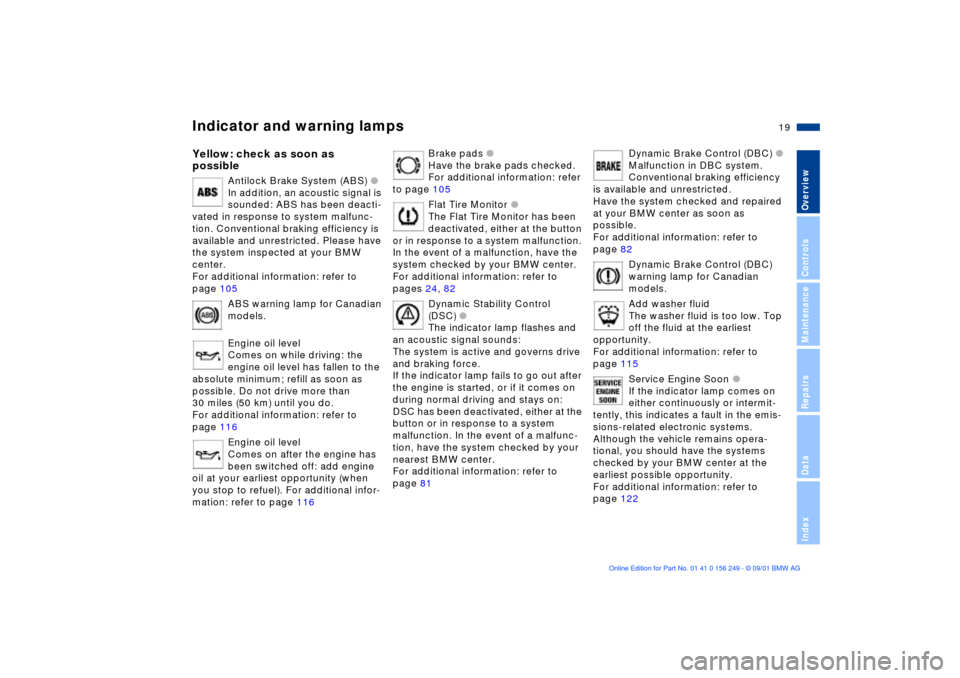
19n
OverviewControlsMaintenanceRepairsDataIndex
Indicator and warning lamps
Yellow: check as soon as
possible
Antilock Brake System (ABS)
l
In addition, an acoustic signal is
sounded: ABS has been deacti-
vated in response to system malfunc-
tion. Conventional braking efficiency is
available and unrestricted. Please have
the system inspected at your BMW
center.
For additional information: refer to
page 105
ABS warning lamp for Canadian
models.
Engine oil level
Comes on while driving: the
engine oil level has fallen to the
absolute minimum; refill as soon as
possible. Do not drive more than
30 miles (50 km) until you do.
For additional information: refer to
page 116
Engine oil level
Comes on after the engine has
been switched off: add engine
oil at your earliest opportunity (when
you stop to refuel). For additional infor-
mation: refer to page 116
Brake pads
l
Have the brake pads checked.
For additional information: refer
to page 105
Flat Tire Monitor
l
The Flat Tire Monitor has been
deactivated, either at the button
or in response to a system malfunction.
In the event of a malfunction, have the
system checked by your BMW center.
For additional information: refer to
pages 24, 82
Dynamic Stability Control
(DSC)
l
The indicator lamp flashes and
an acoustic signal sounds:
The system is active and governs drive
and braking force.
If the indicator lamp fails to go out after
the engine is started, or if it comes on
during normal driving and stays on:
DSC has been deactivated, either at the
button or in response to a system
malfunction. In the event of a malfunc-
tion, have the system checked by your
nearest BMW center.
For additional information: refer to
page 81
Dynamic Brake Control (DBC)
l
Malfunction in DBC system.
Conventional braking efficiency
is available and unrestricted.
Have the system checked and repaired
at your BMW center as soon as
possible.
For additional information: refer to
page 82
Dynamic Brake Control (DBC)
warning lamp for Canadian
models.
Add washer fluid
The washer fluid is too low. Top
off the fluid at the earliest
opportunity.
For additional information: refer to
page 115
Service Engine Soon
l
If the indicator lamp comes on
either continuously or intermit-
tently, this indicates a fault in the emis-
sions-related electronic systems.
Although the vehicle remains opera-
tional, you should have the systems
checked by your BMW center at the
earliest possible opportunity.
For additional information: refer to
page 122
Page 76 of 159
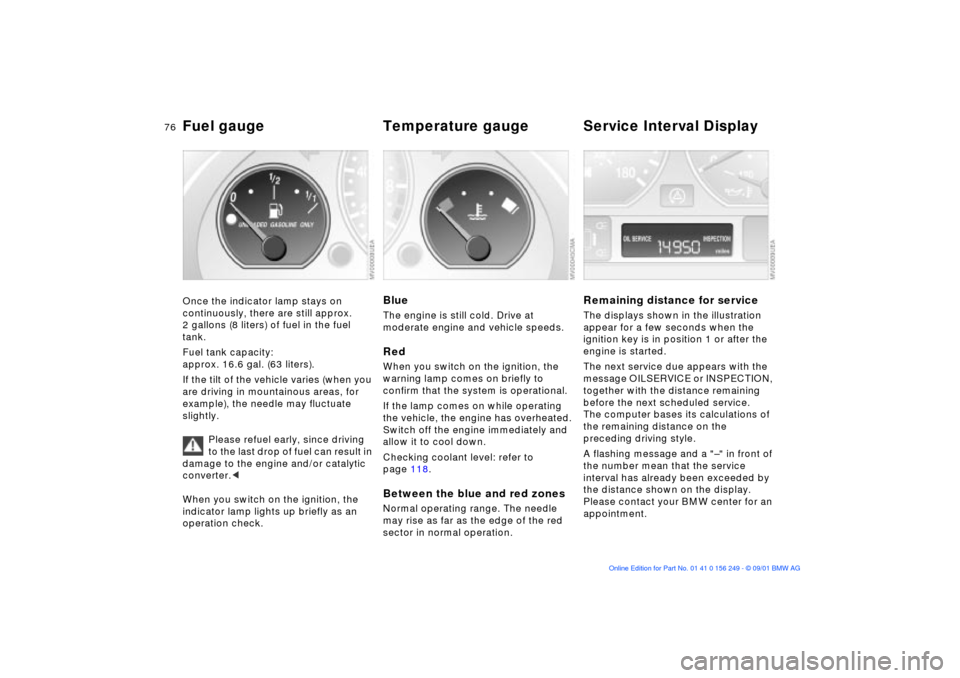
76n
Fuel gauge Temperature gauge Service Interval Display Once the indicator lamp stays on
continuously, there are still approx.
2 gallons (8 liters) of fuel in the fuel
tank.
Fuel tank capacity:
approx. 16.6 gal. (63 liters).
If the tilt of the vehicle varies (when you
are driving in mountainous areas, for
example), the needle may fluctuate
slightly.
Please refuel early, since driving
to the last drop of fuel can result in
damage to the engine and/or catalytic
converter.<
When you switch on the ignition, the
indicator lamp lights up briefly as an
operation check.
BlueThe engine is still cold. Drive at
moderate engine and vehicle speeds. RedWhen you switch on the ignition, the
warning lamp comes on briefly to
confirm that the system is operational.
If the lamp comes on while operating
the vehicle, the engine has overheated.
Switch off the engine immediately and
allow it to cool down.
Checking coolant level: refer to
page 118.Between the blue and red zonesNormal operating range. The needle
may rise as far as the edge of the red
sector in normal operation.
Remaining distance for serviceThe displays shown in the illustration
appear for a few seconds when the
ignition key is in position 1 or after the
engine is started.
The next service due appears with the
message OILSERVICE or INSPECTION,
together with the distance remaining
before the next scheduled service.
The computer bases its calculations of
the remaining distance on the
preceding driving style.
A flashing message and a "Ð" in front of
the number mean that the service
interval has already been exceeded by
the distance shown on the display.
Please contact your BMW center for an
appointment.
Page 114 of 159
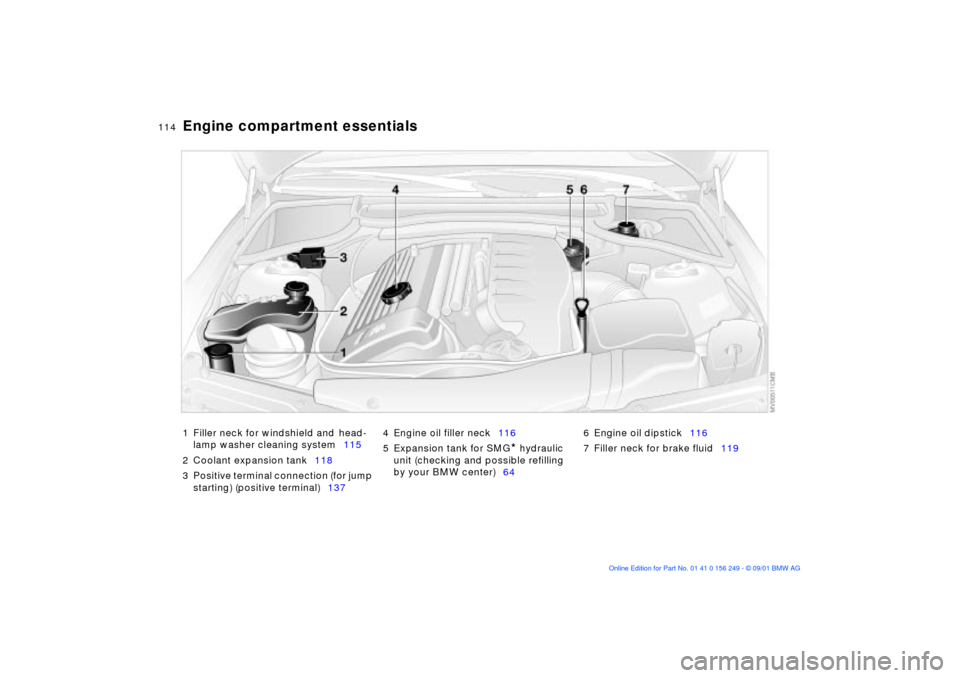
114n
Engine compartment essentials1 Filler neck for windshield and
head-
lamp washer cleaning system115
2 Coolant expansion tank118
3 Positive terminal connection (for jump
starting) (positive terminal)137 4 Engine oil filler neck116
5 Expansion tank for SMG
* hydraulic
unit (checking and possible refilling
by your BMW center)646 Engine oil dipstick116
7 Filler neck for brake fluid119
Page 116 of 159
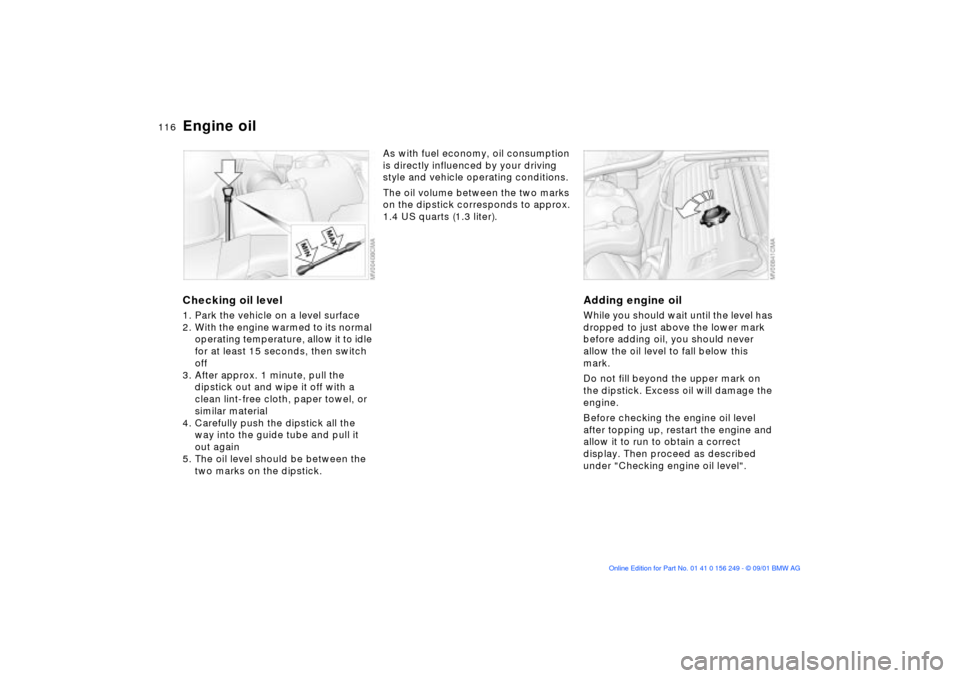
116n
Engine oilChecking oil level 1. Park the vehicle on a level surface
2. With the engine warmed to its normal
operating temperature, allow it to idle
for at least 15 seconds, then switch
off
3. After approx. 1 minute, pull the
dipstick out and wipe it off with a
clean lint-free cloth, paper towel, or
similar material
4. Carefully push the dipstick all the
way into the guide tube and pull it
out again
5. The oil level should be between the
two marks on the dipstick.
As with fuel economy, oil consumption
is directly influenced by your driving
style and vehicle operating conditions.
The oil volume between the two marks
on the dipstick corresponds to approx.
1.4 US quarts (1.3 liter).
Adding engine oil While you should wait until the level has
dropped to just above the lower mark
before adding oil, you should never
allow the oil level to fall below this
mark.
Do not fill beyond the upper mark on
the dipstick. Excess oil will damage the
engine.
Before checking the engine oil level
after topping up, restart the engine and
allow it to run to obtain a correct
display. Then proceed as described
under "Checking engine oil level".
Page 120 of 159
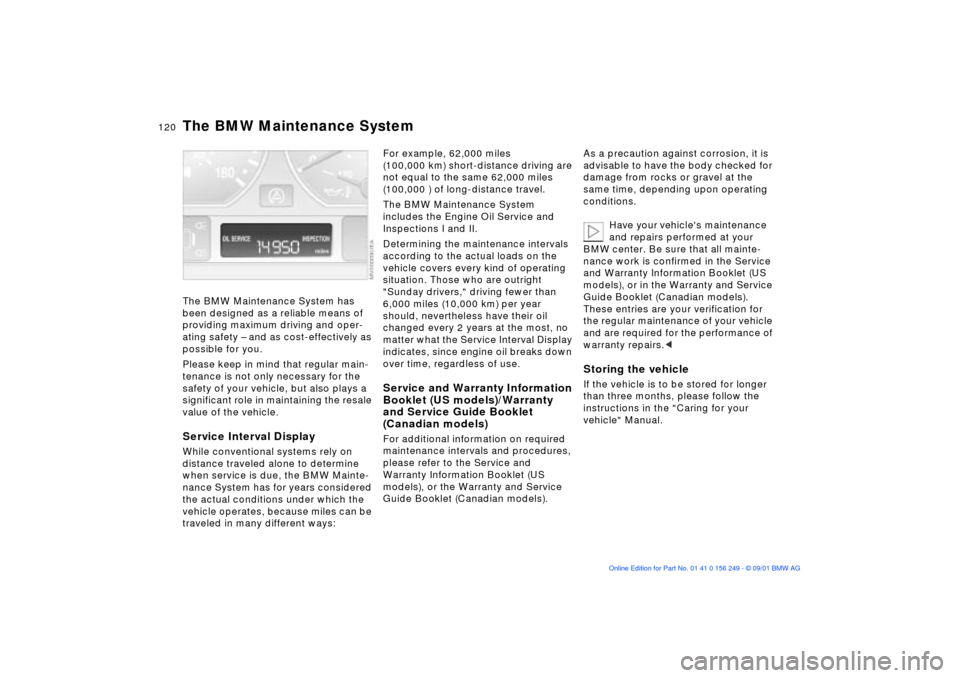
120n
The BMW Maintenance System has
been designed as a reliable means of
providing maximum driving and oper-
ating safety Ð and as cost-effectively as
possible for you.
Please keep in mind that regular main-
tenance is not only necessary for the
safety of your vehicle, but also plays a
significant role in maintaining the resale
value of the vehicle.
Service Interval DisplayWhile conventional systems rely on
distance traveled alone to determine
when service is due, the BMW Mainte-
nance System has for years considered
the actual conditions under which the
vehicle operates, because miles can be
traveled in many different ways:
For example, 62,000 miles
(100,000 km) short-distance driving are
not equal to the same 62,000 miles
(100,000 ) of long-distance travel.
The BMW Maintenance System
includes the Engine Oil Service and
Inspections I and II.
Determining the maintenance intervals
according to the actual loads on the
vehicle covers every kind of operating
situation. Those who are outright
"Sunday drivers," driving fewer than
6,000 miles (10,000 km) per year
should, nevertheless have their oil
changed every 2 years at the most, no
matter what the Service Interval Display
indicates, since engine oil breaks down
over time, regardless of use. Service and Warranty Information
Booklet (US models)/Warranty
and Service Guide Booklet
(Canadian models)For additional information on required
maintenance intervals and procedures,
please refer to the Service and
Warranty Information Booklet (US
models), or the Warranty and Service
Guide Booklet (Canadian models).As a precaution against corrosion, it is
advisable to have the body checked for
damage from rocks or gravel at the
same time, depending upon operating
conditions.
Have your vehicle's maintenance
and repairs performed at your
BMW center. Be sure that all mainte-
nance work is confirmed in the Service
and Warranty Information Booklet (US
models), or in the Warranty and Service
Guide Booklet (Canadian models).
These entries are your verification for
the regular maintenance of your vehicle
and are required for the performance of
warranty repairs.<
Storing the vehicleIf the vehicle is to be stored for longer
than three months, please follow the
instructions in the "Caring for your
vehicle" Manual.
The BMW Maintenance System
Page 147 of 159

147n
OverviewControlsMaintenanceRepairsDataIndex
Capacities
Notes
Fuel tank
Reserve gal. (liters)
gal. (liters)approx. 16.6 (approx. 63)
approx. 2.1 (approx. 8)Fuel specification: refer to page 24
Windshield washer system/
Headlamp washer system quarts (liters) approx. 5.6 (approx. 5.3)For details: refer to page 115
Cooling system including heater circuit quarts (liters) approx. 9.9 (approx. 9.3) For details: refer to page 118
Engine with oil filter change quarts (liters) approx. 5.3 (approx. 5.0) For details: refer to page 117
Manual transmission quarts (liters) approx. 1.9 (approx. 1.8) Oil change during running-in check
and during each inspection II
Differential quarts (liters) approx. 1.2 (approx. 1.1) Oil change during running-in check
and during each inspection II
Page 151 of 159

Everything from A to Z
151n
OverviewControlsMaintenanceRepairsDataIndex
Car wash systems, refer to
the "Caring for your
vehicle" manual
Cargo loading100
CBC (Cornering Brake
Control)105
Cellular phone96
hands-free system96
speaker96
Center (high-mount) brake
lamp131
Center armrest96
Central locking system28
Check Control77
Checking engine coolant
level118t
Checking engine oil
level116t
Child Seat Safety57
Child-restraint systems54
Cigarette lighter97
Clean the headlamps72
Cleaning windshield72
Clock77
also refer to the "Radio
Owner's Manual" or to the
"Onboard Computer
Owner's Manual" Cockpit14
Coin box96
Combination switch70
Compression ratio144
Computer
also refer to the "Onboard
Computer Owner's
Manual"78
Configure personal settings,
Vehicle Memory, Key
Memory60
Connecting electrical
appliances97
Connecting vacuum
cleaner97
Consumption display76
Consumption, fuel79
Control elements14
Convertible top
electrical
malfunction42t
Coolant118, 147
Coolant temperature
gauge76
Cooling system,
capacities147
Copyright4 Cornering Brake Control
(CBC)105
Correct sitting position44
Cruise control73
Cruising range79
Cup holder, refer to
beverage holder96
Curb weight146
D
Dashboard
lighting86
Data
dimensions145
engine144
technical144
weights146
Daytime driving lamps85
Deep water105
Defroster, rear window89
Defrosting the windows92
Digital clock77
also refer to the "Radio
Owner's Manual"
Dimensions145 Dimming inside rearview
mirror51
Dipstick, engine oil116
Disc brakes106
Displacement144
Display lighting86
Displays15
Distance warning80
Door key28
Door mirror50
Doors
electrical
malfunction29t
manual operation29t
remote control30
unlocking and locking29
Draft-free ventilation90, 94
Driving lamps85
Driving notes
aquaplaning105
brakes105
disc brakes106
in general105
DSC (Dynamic Stability
Control)81
Dynamic Stability Control
(DSC)81
indicator lamp19
Page 152 of 159
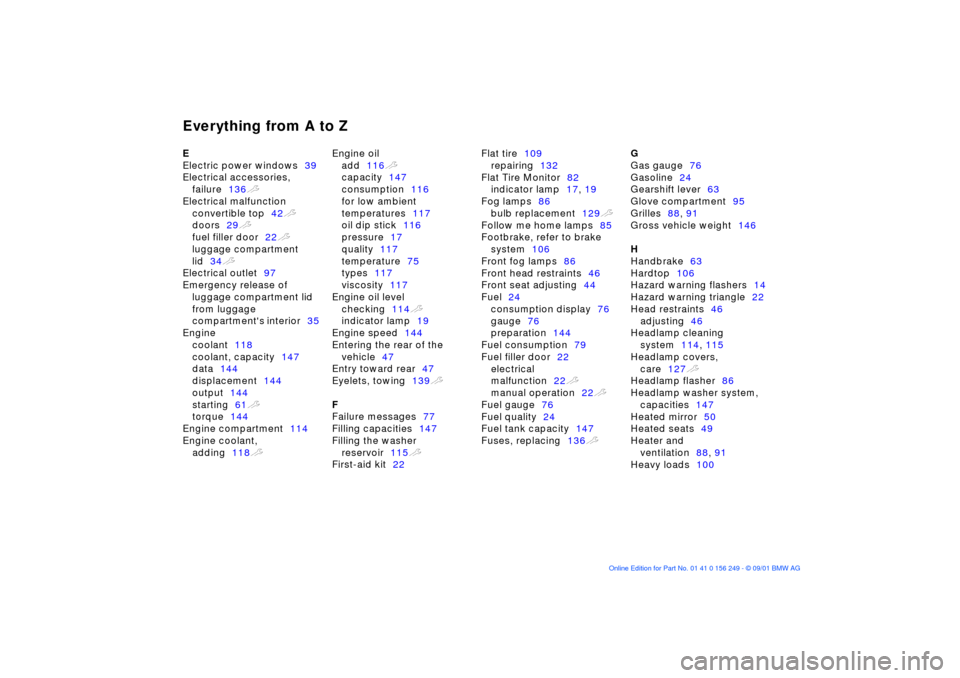
Everything from A to ZE
Electric power windows39
Electrical accessories,
failure136t
Electrical malfunction
convertible top42t
doors29t
fuel filler door22t
luggage compartment
lid34t
Electrical outlet97
Emergency release of
luggage compartment lid
from luggage
compartment's interior35
Engine
coolant118
coolant, capacity147
data144
displacement144
output144
starting61t
torque144
Engine compartment114
Engine coolant,
adding118t Engine oil
add116t
capacity147
consumption116
for low ambient
temperatures117
oil dip stick116
pressure17
quality117
temperature75
types117
viscosity117
Engine oil level
checking114t
indicator lamp19
Engine speed144
Entering the rear of the
vehicle47
Entry toward rear47
Eyelets, towing139t
F
Failure messages77
Filling capacities147
Filling the washer
reservoir115t
First-aid kit22 Flat tire109
repairing132
Flat Tire Monitor82
indicator lamp17, 19
Fog lamps86
bulb replacement129t
Follow me home lamps85
Footbrake, refer to brake
system106
Front fog lamps86
Front head restraints46
Front seat adjusting44
Fuel24
consumption display76
gauge76
preparation144
Fuel consumption79
Fuel filler door22
electrical
malfunction22t
manual operation22t
Fuel gauge76
Fuel quality24
Fuel tank capacity147
Fuses, replacing136t G
Gas gauge76
Gasoline24
Gearshift lever63
Glove compartment95
Grilles88, 91
Gross vehicle weight146
H
Handbrake63
Hardtop106
Hazard warning flashers14
Hazard warning triangle22
Head restraints46
adjusting46
Headlamp cleaning
system114, 115
Headlamp covers,
care127t
Headlamp flasher86
Headlamp washer system,
capacities147
Heated mirror50
Heated seats49
Heater and
ventilation88, 91
Heavy loads100